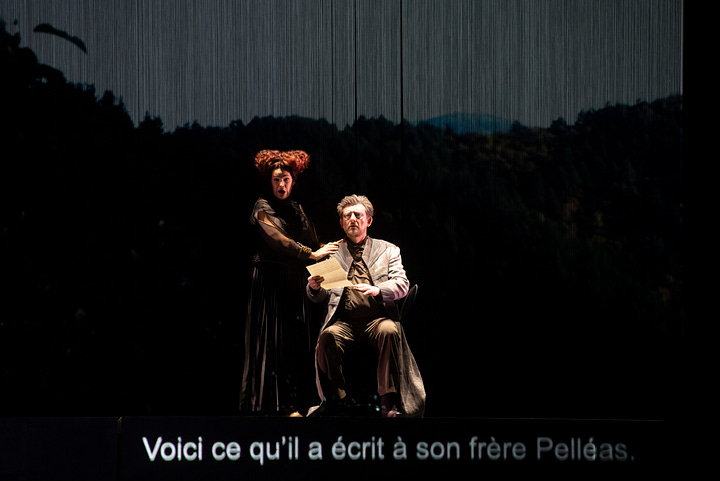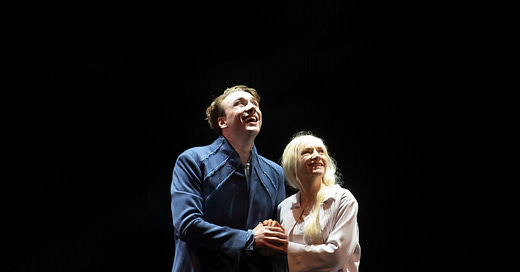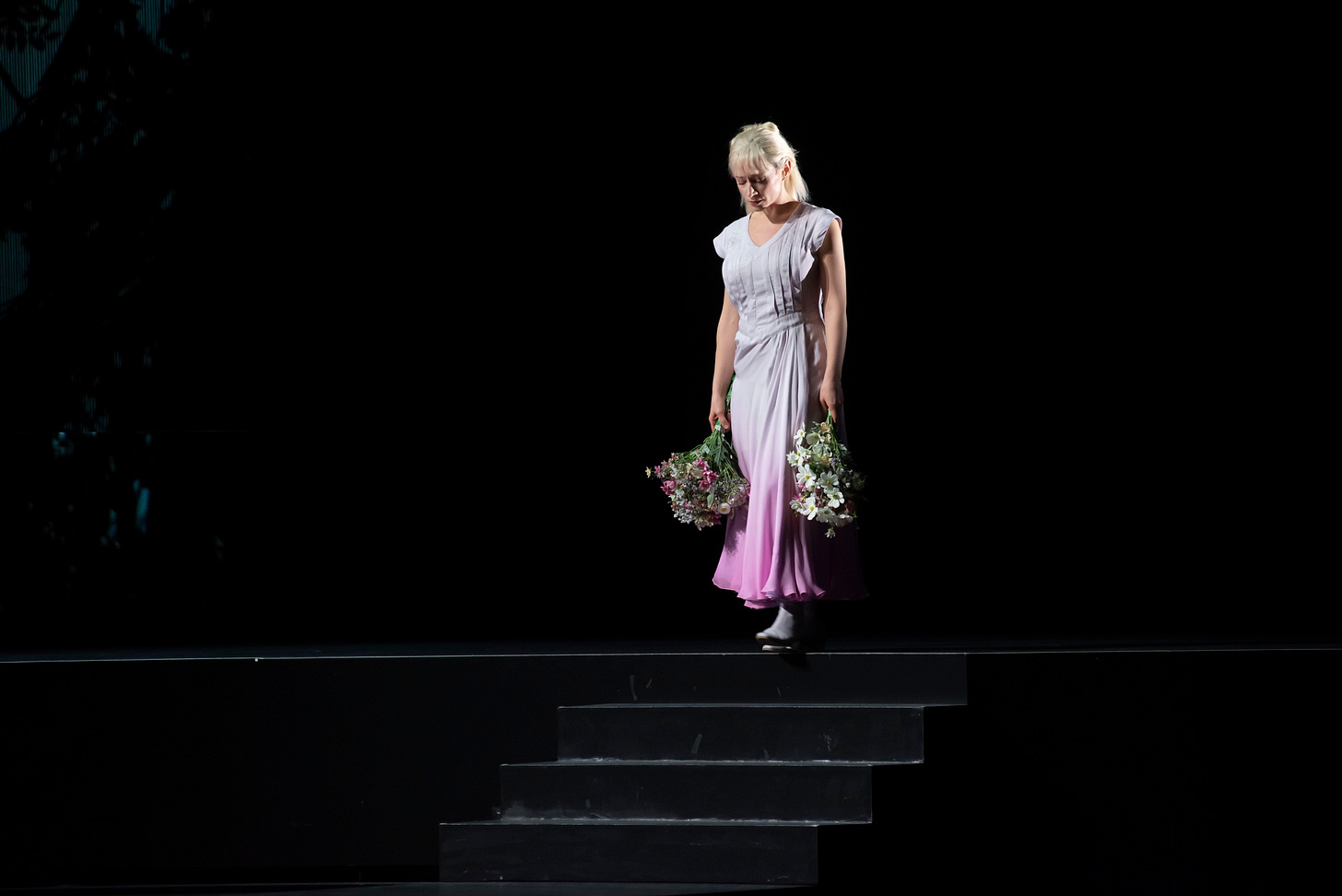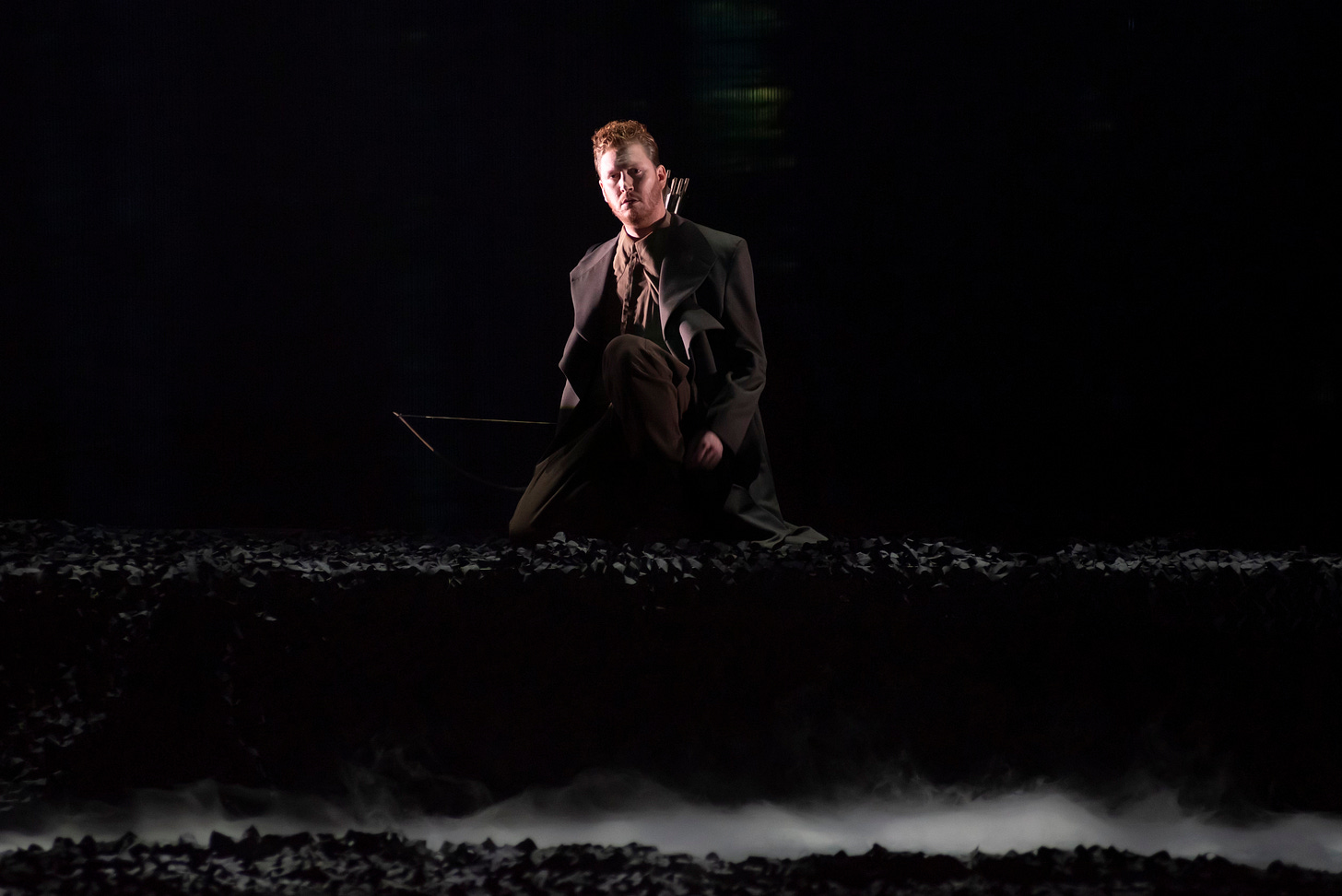A doomed, visceral love
Huw Montague Rendall and Sabine Deviellhe star in the title roles of a new Pelléas et Mélisande at the Opéra-Bastille
This is an edited version of a review which first appeared, in Jan Geisbusch’s German translation, on Oper! Magazin’s website. It is published free for all Operalogue subscribers by kind permission of the editor, Dr. Ulrich Ruhnke
Ideal young lovers: Huw Montague Rendall (Pelléas), Sabine Deviellhe (Mélisande) Picture © Benoîte Fanton
A new Pellets et Mélisande is a big opera event in the French capital, especially after three decades of Robert Wilson’s heavily (some might say over-) stylised staging.
The director chosen to give a new look to Debussy’s drame lyrique is the Lebanese-Canadian Wajdi Mouawad, whose previous work for the Opéra national de Paris, Enescu’s Oedipe, graced the 2021/22 season at the Opéra-Bastille. Enescu’s Sophoclean drama is well suited to a big theatre – unlike Pelléas, written for the more intimate Opéra-Comique in 1902. Debussy’s subtle setting of Maeterlinck’s symbolist play requires an acoustic in which the luminous transparency of the orchestral textures permits the words to be heard.
At the Bastille, the Italian conductor Antonello Manacorda – replacing Gustavo Dudamel, who left his post as the Opéra’s music director after only two seasons, with many projects unfulfilled – captures the impressionism of the “décor orchestral” (as Debussy called his unique instrumentation), and the Opéra chose a youngish cast of light, lyric voices: the interpreters of the title roles, Huw Montague Rendall and Sabine Deviellhe, are among the brightest stars of the younger generation, already ‘crowned’ in the French capital with Erato record contracts. The huge theatre was packed for this important premiere, and the enthusiasm of the audience suggested few were disappointed.
Delicate, fragile Mélisande: Deviellhe Picture © Benoîte Fanton
That said, I spent much of the evening wondering how much more impact this cast would have made in a smaller space. Surely the Opéra-Garnier, the traditional home of opera in the French capital, would have been a more appropriate location for the often chamber-like intimacy of both Maeterlinck’s drama and Debussy’s music?
Mouawad’s production eschews grand gestures and makes rare departures from the narrative. Stéphane Jasmin’s video work is projected onto a screen of threads through which the characters pass like spectres walking through walls. The suggestive images are beautiful: there is a striking sequence in which Mélisande, played in the film sequences by two actresses, Delphine Ghilquin and Azilis Arhan, runs free through fields (Pelléas, Golaud and Geneviève also have filmed ‘doubles’). Jasmin’s imagery favours the natural world, with emphasis on woodland and water, echoing the fluidity of Debussy’s score. Even if Mouawad’s ideas hardly throw new light on the piece, the cumulative effect of the stage pictures, combined with his skilful Personenregie and the histrionic performances of the entire cast, eventually cast a spell.
Young love transcends the cadavers: Montague Rendall (Pelléas), Deviellhe (Mélisande) Picture © Benoïte Fanton
Emmanuel Clolus’s set could easily have been accommodated on a stage a third of the size of the Opéra-Bastille. On a fore-stage, below the screen and main acting area, lie the carcasses of the animals Golaud has been hunting, and Pelléas is eventually murdered by his half-brother while sitting on the torso of an eviscerated horse: this might be overdoing the symbolism, but at least it justified the corpse’s presence. Emmanuelle Thomas’s costumes suggest a time close to the opera’s premiere, without looking old-fashioned. Arkel, for example, wears a long robe, Mélisande a diaphanous fairy-tale princess’s dress.
Notwithstanding the challenge of trying to project into the huge Bastille auditorium, Montague Rendall and Deviellhe are probably as close to ideal for the two title roles as we will get today. With his handsome appearance, accent-free diction and easy top, the English baritone was born to sing Pelléas, even if he has to push the highest-lying passages to make an impact in this theatre: it’s a voice that would sound perfect at Glyndebourne. But for an Englishman to conquer the French in this opera – he won the loudest ovations at curtain-down – is a signal achievement. For the Paris audience, Montague Rendall is already an “étoile”.
Deviellhe’s delicate soprano captures the other-worldly fragility of Mélisande to near-perfection: especially in the tower scene, her singing radiated a folksong-like simplicity that touched the heart. The contrast between her physical frailty and the overpowering strength of Gordon Bintner’s Golaud was shocking, especially in the scene where he throws his child-wife to the ground in a fit of jealous rage.
Physically overpowering Golaud: Gordon Bintner Picture © Benoîte Fanton
This Canadian bass-baritone, another rising star on international stages, was insufficiently differentiated, vocally, from Montague Rendall. Both have lyric voices and share several roles – Count Almaviva in Le nozze di Figaro, Don Giovanni, Gulgielmo in Così fan tutte. Indeed one could easily imagine Bintner singing Pelléas in large American theatres (or even at the Bastille). His Golaud boasts an imposing physical presence and a characterisation that descends into the abyss, the result of blind jealousy.
In the older-generation roles of Geneviève and Arkel, Sophie Koch and Jean Teitgen were luxury casting, drawing the listener in to their long narrations. As Golaud’s son Yniold, Anne-Blanche Trillaud Ruggeri, from Radio France’s training school, revealed a fresh ‘voix blanche’: it is not her fault that the Bastille does not flatter youthful voices.


Anne-Blanche Trillaud Ruggeri (Yniold), Sophie Koch (Geneviève), Jean Teitgen (Arkel) Pictures © Benoîte Fanton
Cast & Creative Team
Pelléas et Mélisande: Opéra-Bastille
Pelléas Huw Montague Rendall Mélisande Sabine Deviellhe Golaud Gordon Bintner
Arkel Jean Teitgen Geneviève Sophie Koch Yniold Anne-Blanche Trillaud Ruggeri
Conductor Antonello Manacorda Director Wajdi Mouawad Sets Emmanuel Clolus
Costumes Emmanuelle Thomas Lighting Éric Champoux Video Stéphanie Jasmin
Dramaturgy Charlotte Farcet
Chorus master Alessandro de Stefano
Performance attended: February 28
Further performances: March 12, 15, 18, 20, 25, 27
Website: operadeparis.fr







